
Fort Cornwallis, George Town
Fort Cornwallis, located adjacent to The Esplanade, is Malaysia's oldest and largest fort. Completed in 1810 by the British to protect Penang Island, the fort marks the spot where Captain Francis Light, the founder of Penang Island, first landed in 1786. It is now one of the most famous landmarks in George Town. A statue of Captain Francis Light also stands within the fort.

Northeastern point of Fort Cornwallis
The original Fort Cornwallis was built at the spot where Light first landed on Penang Island in 1786. It was initially built using nibong palms. It was gradually rebuilt with bricks into the fort we see today. Several cannons were brought into the fort, such as the historical Seri Rambai cannon.
Fort Cornwallis is bounded by Light Street to its south, Jalan Tun Syed Sheh Barakbah to the east and to the north, and The Esplanade to the west.
History[]
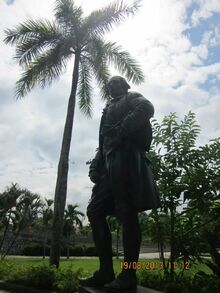
A statue of Captain Francis Light now stands inside Fort Cornwallis, the spot where he first landed on 17 July 1786.
Fort Cornwallis marked the spot where Captain Francis Light first landed on 17 July 1786. Two weeks later, after clearing the surrounding jungles, he constructed a simple stockade made of nibong palms, a species of palm native to Penang Island. It was built to protect Penang Island from pirates and foreign powers, including the Sultanate of Kedah from which Light gained the island.
The fort was named in honour of Charles Marquis Cornwallis, the then Governor-General of Bengal who had lost to George Washington in the 1781 Battle of Yorktown during the American Revolutionary War. This defeat had led to the recognition of United States' independence. Coincidentally, Penang Island, then known as the Prince of Wales Island, was the first British settlement founded since the loss of the 13 American colonies.
In 1789, three years after the simple stockade was completed, Light began rebuilding the fort using bricks. The new design, which features a star-shaped fort, was similar with other British forts in India. Indian convict labourers were brought in for the construction of the brick fort. It was completed in 1793 at a cost of $67,000 (Spanish dollar).
In 1797, Colonel Wellesley, who would later gain fame as the Duke of Wellington by defeating Napoleon Bonaparte, reported that the location of Fort Cornwallis, at the tip of the promontory where George Town stands, rendered it useless to defend the Prince of Wales Island. This sparked an argument of whether Fort Cornwallis and, by extension, George Town should be shifted.
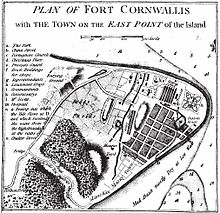
A 1799 map of George Town, featuring both Fort Cornwallis and The Esplanade.
After the Prince of Wales Island was made a Presidency of India in 1805, the British authorities looked for ways to improve the island's defences. At the time, the Napoleonic Wars, started by the then French Emperor Napoleon Bonaparte, was at its height, making it imperative for the British to defend the island against French threats. The British considered abandoning George Town in favour of a proposed settlement of Jamestown, to be built at what is now Bayan Baru. A new fort was to be built on Jerejak Island opposite Jamestown.
Even though the British authorities formed a separate revenue farm for Jamestown, the proposed relocation was eventually scrapped, as the residents of George Town found it too expensive to move. Therefore, Fort Cornwallis was repaired and rebuilt between 1804 and 1810. Land was reclaimed to the east of the fort for the construction of a semi-circular battery facing the sea. This eastern battery, where Jalan Tun Syed Sheh Barakbah now runs, has since been eroded into the sea.
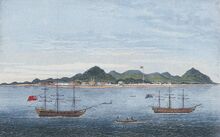
An 1810 painting of George Town, in which Fort Cornwallis can be clearly seen.
Nevertheless, Fort Cornwallis was completed in 1810 at a cost of $80,000 (Penang dollar) - an enormous amount at the time.
Fort Cornwallis also witnessed the birth of Malaysia's modern legal system, when in 1808, the Supreme Court of Penang was sited within the fort. The Supreme Court has since been shifted to its present premises at nearby Light Street.
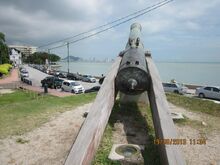
Seri Rambai cannon, Fort Cornwallis, George Town. Rumour has it that women who put flowers on its magical barrel will conceive much easier.
By 1814, 77 cannons were installed along the brick walls of Fort Cornwallis, with a further 45 in reserve. Today, only 17 remain, the most famous being the Seri Rambai cannon. This Dutch-made cannon was given to the Sultan of Johor in 1606. Portuguese forces seized it in 1613 and took it to Java, where it remained until 1795. The cannon was then given to Acheh, before being moved again to Kuala Selangor. It was eventually seized by the British in 1871. Since then, it stays at the northwestern corner of Fort Cornwallis.
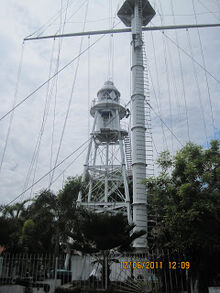
The Fort Cornwallis Lighthouse was added at the northeastern corner of Fort Cornwallis in 1882. An adjacent flagstaff was installed to signal the arrival of mail ships to other flagstaff on Penang Hill, as well as to receive signals from Penang Hill every time the Governor and other dignitaries descended from the hill.
Along with the lighthouse, two roads were laid along the eastern and northern sides of the fort - Fort Road and The Esplanade. Both roads were renamed Jalan Tun Syed Sheh Barakbah in the 1970s.

An old picture of Fort Cornwallis.
A moat 9 metres wide and 2 metres deep originally surrounded the fort, but it was filled up in the 1920s to combat a malaria epidemic at the time.
Although the fort was intended to defend Prince of Wales Island, since its completion in 1810, the fort has never fired a shot in anger. In fact, in its initial years, the fort functioned more as an administrative centre of the British East India Company than as a defensive fort. After the British Army vacated the fort in 1886, it housed the Straits Settlement's Sikh and European policemen. During World War 2, the Japanese used the fort as a detention centre, as well as a site for military workshops and storehouses.
The fort has also been modified in the 1970s, when the double walls on its western side were torn down to give way for sewage piping and electrical equipments. An iron fence was also placed along the western side of the fort. In addition, a modern amphitheatre was installed inside the fort in the early 1970s to be used for cultural performances. In 1991, the management of Fort Cornwallis was privatised by the Penang state government in an effort to enhance its appeal as a prime tourist destination.
Structures[]

The abandoned Fort Cornwallis chapel.
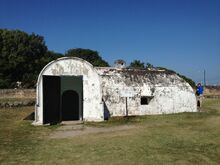
The arms magazine inside Fort Cornwallis.
- Gunpowder Storeroom
- Arms Magazine
- Conductor's Quarters
- Chapel
- Storerooms
- Guardroom
- Former 19th. century Shipyard
- Fort Cornwallis Lighthouse
Travel Advice[]
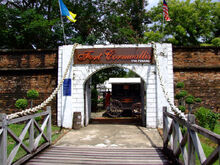
Fort Cornwallis can be accessed from either the western entrance facing The Esplanade or the eastern entrance facing Swettenham Pier.
*All prices are quoted in Malaysian Ringgit (RM).
Tour guides dressed in historic British Army red coats are available inside the fort. You may also try out more colonial-era outfits while taking pictures inside the fort.
Fort Cornwallis opens between 0900 and 2200 hours daily. Admission fees are as follows.
Foreigners :
- Adults : RM20
- Children : RM10
Malaysians :
- Adults : RM10
- Children : RM5
Political Representation[]
Penang State Government[]
N.26 Padang Kota State Assemblyman : Chow Kon Yeow (Democratic Action Party)
Malaysian Federal Parliament[]
P.049 Tanjong Member of Parliament : Ng Wei Aik (Democratic Action Party)
References[]
- Hockton, K., Howard Tan, 2012. Penang : An Inside Guide to Its Historic Homes, Buildings, Monuments and Parks. MPH Group, Kuala Lumpur.
- Langdon, M. A Guide to George Town's Historic Commercial and Civic Precints. Penang : George Town World Heritage Incorporated.
- http://www.penang-traveltips.com/fort-cornwallis.htm
- http://www.penang-traveltips.com/historical-plan-to-relocate-george-town.htm
- http://www.penang-traveltips.com/fort-cornwallis-lighthouse.htm
- http://www.penang-vacations.com/fort-cornwallis.html
- http://www.hbp.usm.my/conservation/ConsProject/Fortarticle.htm